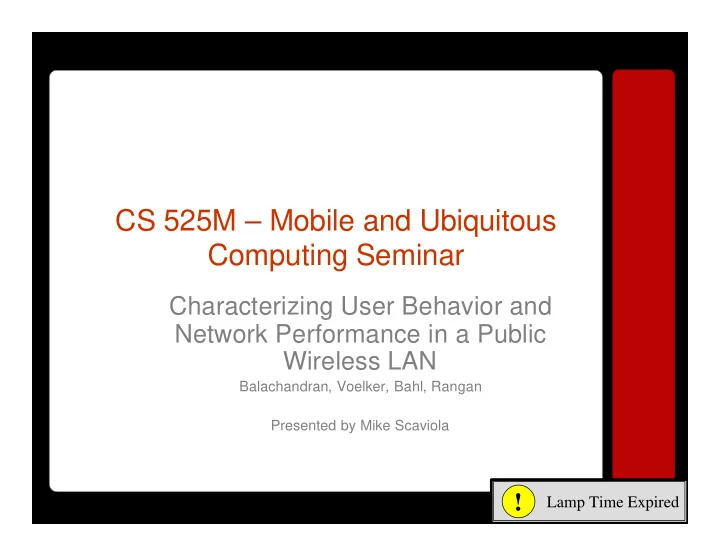

CS 525M – Mobile and Ubiquitous Computing Seminar Characterizing User Behavior and Network Performance in a Public Wireless LAN Balachandran, Voelker, Bahl, Rangan Presented by Mike Scaviola ! Lamp Time Expired
Outline • Introduction • Network Environment and Data Collection • Analysis of Results – User Behavior – Network Performance • Conclusion ! Lamp Time Expired
Introduction • Analysis of user behavior and network performance in a public-area wireless network – Captured data from a 3-day ACM conference at UC San Diego, 2001 • 2 phases – Monitored SNMP data from 4 APs – Packet headers of all wireless traffic ! Lamp Time Expired
Goals • Gain knowledge of wireless user behavior, wireless network performance. Identify wireless workload characteristics. • Characterize user behavior for use with analytic and simulation studies • Better understanding of wireless network deployment issues ! Lamp Time Expired
Network Environment • 802.11b network in conference auditorium. 110x60x27 ft • 4 ORiNOCO AP-1000 wireless access points in ceiling. • 195 users (40% of attendees). • Wireless cards from 8 different vendors ! Lamp: 5 min remaining
Trace Collection • SNMP data from each AP for 52 hours – Wrote snmputil to walk the MIB tree every minute. Post-processed with perl scripts. • Tcpdump trace of packet headers from cisco 2924 switch. – Analyzed using CoralReef software ! Lamp: 3 min remaining
User Behavior • Number of associated users climbs to a peak when conferences are in session, falls sharply during breaks. Lamp Temp Exceeded
User Behavior • User arrivals – Steady increase as sessions start, decrease as sessions conclude. – Correlations in time and space • Modeled as a Markov-Modulated Poisson Process (MMPP) – Two states: ON, OFF • ON – Random arrivals at constant rate • OFF – No arrivals into the system – Mean inter-arrival time is 38 seconds – Mean OFF state duration: 6 minutes ! Warning: Lamp on fire
Session Duration •90% of sessions last less than one hour. 10% are between one and 3 hours. •Fits the General Pareto Distribution with shape parameter .78 and scale parameter 30.76 . (Coefficient of determination is 0.9) •Long sessions are mainly idle ! Warning: Lamp on fire
Session Duration •Implications – Short session times means DHCP servers can have shorter lease times. – A good way to deal with limited IP addresses by recycling them quickly. ! Warning: Lamp on fire
User Data Rates •Data rates are relatively low and correlate with session times. •Bandwidth range from 15kbps to 590kbps •3 intervals of bandwidth distribution – Light: Lower 25 th percentile – Medium: 25 th to 90 th percentile – Heavy: top 10% •Long sessions have a low average data rate – All sessions longer than 40 minutes are light ! Exhaust Fan Failure
Application Popularity •TCP is 91% of traffic, by byte count. (76% of all flows) •HTTP is 46% of total bytes •SSH: 18% •Users rely on application-level security ! LCD Meltdown Imminent
User Mobility •Users were mobile a the beginning and end of conference sessions. •80% of users seen at more than one AP •16% stationary – Majority of stationary users had longer sessions Radiation Leak
User Behavior Summary • Users evenly distributed across APs – Arrivals correlated in time and space • Most sessions are short. 60% < 10 minutes – Longer sessions are typically idle • Sessions are either light, medium, or heavy and range from 15-590kbps • HTTP and SSH total 64% of bytes and 58% of flows. • Users are mobile when expected. ! Evacuating Personnel
Network Performance • Load peaks from 11am-12:30 and drops during lunch. – Peak throughput of 3.2mbps • Uneven load distribution across APs – 37% difference between NE and SW – Due to application workload of users • Load is sensitive to individual bandwidth requirements, not number of users • Peak load does not occur when number of users is at maximum. ! Self Destruct in 5 min
Channel Characteristics •Packet error rate obtained from SNMP •Error rates are bursty, and correlate to a large number of handoffs •Error greater than normally used in simulations – Difference due to measurement at packet-level rather than bit-level •Number of link-level retransmissions does not match number of errors because MAC beacons are not retransmitted. ! Self Destruct in 3 min
Summary of Performance • “Not surprisingly”, load correlates with conference schedule • Bandwidth is determined by individual behavior • Network is overprovisioned with 4 APs for 195 users. • Wireless channel characteristics are similar for all APs, more time-dependent than location-dependent. ! Self Destruct in 1 min
Conclusions • Most sessions are relatively short • DHCP can be configured with short lease times • Few APs are needed for a large number of users • Study is characterized by concentrated space and scheduled use and would share characteristics with classrooms, airports, etc. ! Self Destruct activated
Recommend
More recommend